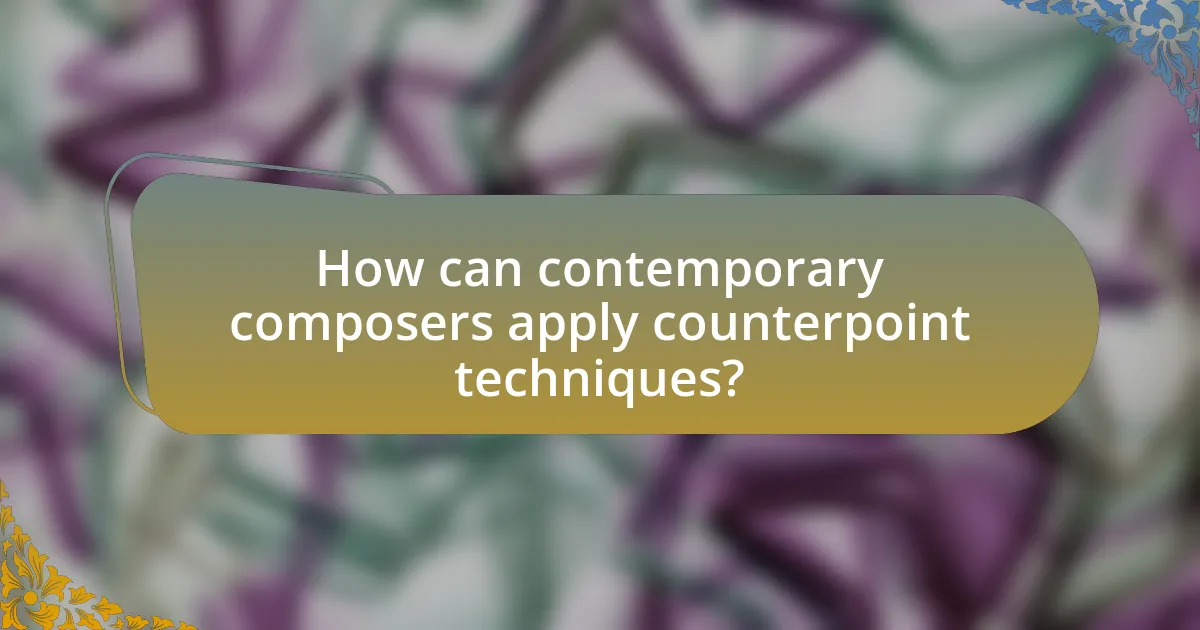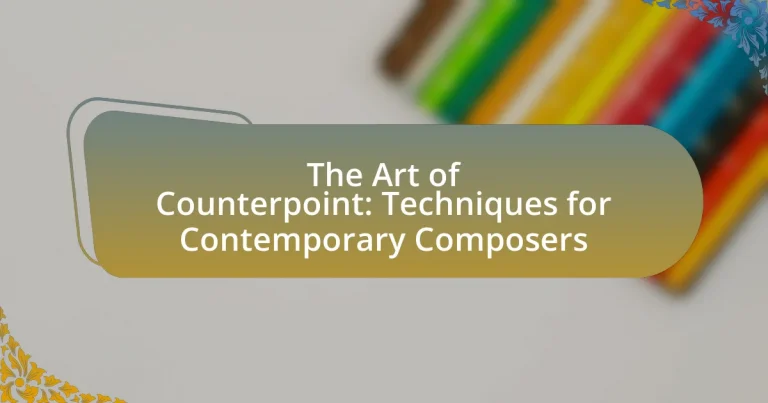The Art of Counterpoint is a compositional technique that emphasizes the interplay of independent melodic lines to create harmony, rooted in Renaissance and Baroque practices. This article explores the evolution of counterpoint in contemporary music, highlighting its integration with diverse styles and modern technologies. It examines historical techniques that influence modern counterpoint, the reinterpretation of traditional methods by contemporary composers, and the importance of counterpoint in enhancing musical complexity and emotional expression. Additionally, it discusses practical exercises for mastering counterpoint, common challenges faced by composers, and best practices for effectively incorporating counterpoint into compositions.

What is the Art of Counterpoint?
The Art of Counterpoint is a compositional technique that involves the interplay of independent melodic lines to create harmony. This method, rooted in the practices of the Renaissance and Baroque periods, emphasizes the relationship between voices, where each line maintains its distinctiveness while contributing to the overall musical texture. Historical figures such as Johann Sebastian Bach exemplified counterpoint through works like “The Well-Tempered Clavier,” showcasing how multiple melodies can coexist and enhance one another, thus validating the effectiveness of counterpoint in music composition.
How has counterpoint evolved in contemporary music?
Counterpoint in contemporary music has evolved to incorporate diverse styles and techniques, moving beyond traditional Western classical frameworks. Contemporary composers often blend counterpoint with elements from jazz, electronic music, and world music, resulting in innovative textures and complex harmonic structures. For instance, composers like Steve Reich and Philip Glass utilize minimalism, where counterpoint is expressed through repetitive motifs and phasing techniques, creating a rich tapestry of interwoven lines. Additionally, the use of technology in music production allows for new forms of counterpoint, such as layering multiple tracks in digital audio workstations, which expands the possibilities for interaction between melodic lines. This evolution reflects a broader trend in contemporary music towards experimentation and the fusion of genres, demonstrating that counterpoint remains a vital and adaptable component of musical composition today.
What historical techniques influence modern counterpoint?
Historical techniques that influence modern counterpoint include species counterpoint, developed by Johann Joseph Fux in the 18th century, and the contrapuntal practices of the Renaissance, particularly those of Palestrina. Species counterpoint provides a systematic approach to voice leading and dissonance treatment, which remains foundational in contemporary composition. The Renaissance practices emphasize the importance of melodic independence and harmonic progression, which are integral to modern counterpoint. These historical methods are still taught in music theory and composition courses, demonstrating their lasting impact on contemporary composers.
How do contemporary composers reinterpret traditional counterpoint?
Contemporary composers reinterpret traditional counterpoint by integrating modern harmonic languages, diverse rhythmic structures, and unconventional textures. For instance, composers like Steve Reich and Philip Glass utilize repetitive patterns and phasing techniques, which diverge from classical counterpoint’s strict rules while maintaining polyphonic textures. Additionally, composers such as Caroline Shaw and Anna Clyne blend counterpoint with elements from various genres, including folk and electronic music, creating innovative soundscapes that challenge traditional boundaries. This evolution reflects a broader trend in contemporary music where the essence of counterpoint is preserved, yet its application is expanded to include new influences and technologies.
Why is counterpoint important for contemporary composers?
Counterpoint is important for contemporary composers because it enhances musical complexity and depth, allowing for the creation of intricate textures and harmonies. By employing counterpoint, composers can develop their thematic material in a way that engages listeners through interweaving melodies, which has been a foundational technique in Western music since the Renaissance. Historical examples, such as the works of J.S. Bach, demonstrate how counterpoint can elevate musical expression and innovation. Contemporary composers, like Steve Reich and Philip Glass, utilize counterpoint to create rich, layered compositions that challenge traditional harmonic structures and engage modern audiences. Thus, counterpoint remains a vital tool for contemporary composers seeking to push the boundaries of musical language.
What role does counterpoint play in musical complexity?
Counterpoint significantly enhances musical complexity by allowing multiple independent melodies to coexist harmoniously. This technique creates intricate textures and enriches the overall sound, as seen in the works of composers like Johann Sebastian Bach, who employed counterpoint to develop elaborate musical structures. The interplay of voices in counterpoint not only adds depth but also introduces tension and resolution, which are essential elements in creating engaging compositions.
How does counterpoint enhance emotional expression in music?
Counterpoint enhances emotional expression in music by creating intricate relationships between independent melodic lines, allowing for a richer harmonic texture. This complexity enables composers to convey a wider range of emotions, as the interplay between voices can evoke feelings of tension, resolution, and contrast. For example, in Johann Sebastian Bach’s works, counterpoint often reflects emotional depth through the use of dissonance and resolution, illustrating how different melodies can interact to express complex sentiments. The layering of melodies in counterpoint not only adds depth but also invites listeners to engage with the music on multiple levels, enhancing the overall emotional experience.

What are the fundamental techniques of counterpoint?
The fundamental techniques of counterpoint include species counterpoint, voice leading, and the use of dissonance and consonance. Species counterpoint, developed by Johann Joseph Fux, categorizes counterpoint into five species, each with specific rules governing the relationship between melodic lines. Voice leading focuses on the smooth movement of individual melodic lines, ensuring that each voice progresses logically and harmonically. The treatment of dissonance and consonance is crucial, as counterpoint often involves creating tension through dissonance that resolves into consonance, adhering to established harmonic practices. These techniques form the basis of counterpoint, influencing both historical and contemporary compositions.
How do composers implement voice leading in counterpoint?
Composers implement voice leading in counterpoint by ensuring that individual melodic lines move smoothly and logically from one note to the next. This is achieved through principles such as maintaining stepwise motion, avoiding large leaps, and resolving dissonances appropriately. For example, in traditional counterpoint, composers often use techniques like contrary motion, where one voice moves up while another moves down, to create a sense of balance and independence among the lines. Additionally, composers adhere to rules regarding the spacing of voices and the treatment of intervals to maintain harmonic coherence. These practices are foundational in counterpoint, as seen in the works of composers like Johann Sebastian Bach, who exemplified effective voice leading through intricate yet clear melodic interactions.
What are the principles of good voice leading?
Good voice leading is characterized by smooth, logical movement between individual musical lines, ensuring that each voice maintains its independence while contributing to the overall harmony. Key principles include minimizing large leaps, maintaining common tones, and using stepwise motion whenever possible. These practices help create a cohesive sound and facilitate smooth transitions between chords. For example, in traditional Western harmony, the movement of voices often follows the rules of counterpoint, which emphasize the importance of consonance and dissonance resolution, as outlined in texts like “Counterpoint in Composition” by David Stevenson.
How does voice leading affect harmonic progression?
Voice leading significantly affects harmonic progression by determining how individual musical lines move from one chord to another. Effective voice leading minimizes the distance between notes in different voices, creating smoother transitions and enhancing the overall coherence of the harmonic structure. For instance, in traditional Western music, the principle of common tones encourages the retention of shared notes between chords, which facilitates a seamless progression. This technique is evident in the works of composers like Johann Sebastian Bach, who employed voice leading to create intricate yet harmonious relationships between melodies and harmonies. Thus, the principles of voice leading are essential for achieving fluid and expressive harmonic progressions in composition.
What types of counterpoint are commonly used today?
The types of counterpoint commonly used today include species counterpoint, free counterpoint, and imitative counterpoint. Species counterpoint, which is based on a systematic approach to writing counterpoint in five distinct species, is often taught in music education to develop foundational skills. Free counterpoint allows for more creative freedom and is frequently employed in contemporary compositions, enabling composers to explore complex textures and harmonies. Imitative counterpoint, characterized by the repetition of a musical idea in different voices, remains prevalent in various genres, including jazz and popular music, showcasing its adaptability and relevance in modern compositions.
What distinguishes strict counterpoint from free counterpoint?
Strict counterpoint is characterized by adherence to specific rules governing the relationship between melodic lines, while free counterpoint allows for more flexibility and creativity in these relationships. In strict counterpoint, composers follow established guidelines such as consonance and dissonance treatment, voice leading, and intervallic relationships, often seen in the works of composers like Johann Sebastian Bach. In contrast, free counterpoint permits deviations from these rules, enabling composers to explore more innovative and expressive musical ideas, as exemplified in the works of later composers like Igor Stravinsky. This distinction highlights the balance between structure and creativity in the art of counterpoint.
How do composers utilize imitative counterpoint in their works?
Composers utilize imitative counterpoint by creating multiple independent melodies that echo each other, enhancing the texture and complexity of their works. This technique allows for thematic development, as seen in the works of Johann Sebastian Bach, who often employed imitation to build intricate musical dialogues between voices. For instance, in his “Fugue in C Minor,” Bach demonstrates how imitative counterpoint can create a cohesive yet diverse musical narrative, where each voice contributes to the overall structure while maintaining its individuality. This method not only enriches the harmonic landscape but also engages listeners through the interplay of melodic lines, making it a fundamental aspect of counterpoint in contemporary compositions.

How can contemporary composers apply counterpoint techniques?
Contemporary composers can apply counterpoint techniques by integrating independent melodic lines that interact harmonically and rhythmically. This approach allows for the creation of complex textures and rich musical narratives, as seen in the works of composers like Steve Reich and Philip Glass, who utilize counterpoint to develop their minimalist styles. By employing techniques such as imitation, inversion, and augmentation, these composers enhance the depth of their compositions, demonstrating the versatility of counterpoint in modern music.
What are practical exercises for mastering counterpoint?
Practical exercises for mastering counterpoint include writing two-voice counterpoint exercises, where composers create melodies that adhere to the rules of consonance and dissonance, ensuring that each voice maintains independence while harmonizing with the other. Additionally, composers can practice by harmonizing a given melody in counterpoint, focusing on maintaining the integrity of the original line while adding a complementary voice. Another effective exercise is to analyze and transcribe counterpoint from classical works, such as those by J.S. Bach, to understand the techniques used in real compositions. These exercises are validated by the pedagogical approaches found in music theory texts, which emphasize the importance of hands-on practice in developing counterpoint skills.
How can composers practice writing counterpoint in different styles?
Composers can practice writing counterpoint in different styles by analyzing and emulating the works of established composers known for their counterpoint, such as Johann Sebastian Bach and Igor Stravinsky. This method involves studying their scores to understand the techniques they employed, such as voice leading, dissonance treatment, and rhythmic interplay. Additionally, composers can engage in exercises that focus on specific styles, like writing two-part inventions or creating fugues, which are foundational forms in counterpoint. Historical context supports this approach, as many composers throughout history, including Bach, developed their skills by imitating the styles of their predecessors. This practice not only enhances technical proficiency but also deepens understanding of stylistic nuances across different musical eras.
What tools and software can assist in counterpoint composition?
Tools and software that assist in counterpoint composition include MuseScore, Sibelius, and Finale. MuseScore is a free notation software that allows composers to create and edit scores while providing features for counterpoint analysis. Sibelius offers advanced notation capabilities and tools for voice leading, making it suitable for counterpoint work. Finale provides extensive customization options and supports complex counterpoint structures, enabling composers to experiment with various contrapuntal techniques. These tools are widely used in the music composition community, demonstrating their effectiveness in facilitating counterpoint composition.
What are common challenges faced when using counterpoint?
Common challenges faced when using counterpoint include maintaining independence of voices, achieving harmonic coherence, and ensuring rhythmic balance. Composers often struggle with the need for each melodic line to be distinct while still fitting harmonically within the overall structure. This complexity can lead to dissonance if not managed properly, as seen in the works of composers like Johann Sebastian Bach, who mastered the balance of these elements. Additionally, rhythmic coordination among voices can be difficult, as counterpoint requires careful attention to how different lines interact rhythmically to create a cohesive musical texture.
How can composers overcome the complexities of counterpoint?
Composers can overcome the complexities of counterpoint by systematically studying and applying established counterpoint rules, such as those outlined by Johann Joseph Fux in “Gradus ad Parnassum.” This foundational text provides a structured approach to counterpoint, emphasizing the importance of voice leading, consonance, and dissonance management. Additionally, composers can practice writing counterpoint exercises, such as species counterpoint, which breaks down the process into manageable steps, allowing for gradual mastery of the technique. Engaging with historical counterpoint works, analyzing the techniques used by masters like Bach and Palestrina, further enhances understanding and application. By combining theoretical knowledge with practical exercises, composers can effectively navigate the intricacies of counterpoint.
What mistakes should composers avoid in counterpoint writing?
Composers should avoid parallel fifths and octaves in counterpoint writing, as these create a lack of independence between voices. This principle is rooted in traditional counterpoint rules established by theorists like Johann Joseph Fux, who emphasized the importance of maintaining distinct melodic lines. Additionally, composers should refrain from excessive dissonance without proper resolution, as unresolved dissonance can disrupt the harmonic flow and clarity of the piece. Lastly, neglecting voice leading principles, such as smooth melodic transitions and proper spacing between voices, can lead to awkward and unmusical results. These mistakes can diminish the effectiveness of counterpoint and compromise the overall quality of the composition.
What best practices should contemporary composers follow in counterpoint?
Contemporary composers should prioritize voice independence, harmonic clarity, and rhythmic variety in counterpoint. Voice independence ensures that each melodic line maintains its distinct character, allowing for richer textures and interactions. Harmonic clarity involves using consonant intervals and avoiding excessive dissonance, which can create confusion in the listener’s perception of harmony. Rhythmic variety adds interest and complexity, preventing monotony and enhancing the overall musical narrative. These practices are supported by historical counterpoint techniques, such as those outlined by Johann Joseph Fux in “Gradus ad Parnassum,” which emphasize the importance of these elements in creating effective counterpoint.
How can composers effectively integrate counterpoint into their compositions?
Composers can effectively integrate counterpoint into their compositions by employing techniques such as voice independence, melodic interplay, and harmonic support. Voice independence ensures that each melodic line maintains its distinct character while interacting with others, which is fundamental in counterpoint. Melodic interplay involves creating lines that complement and contrast with one another, often using techniques like imitation and inversion. Harmonic support provides a foundation for the counterpoint, ensuring that the combined lines create a cohesive harmonic structure. Historical examples, such as Johann Sebastian Bach’s works, illustrate these techniques, showcasing how effective counterpoint enhances musical complexity and richness.
What resources are available for further learning about counterpoint?
Books such as “Counterpoint in Composition” by David Stevenson and “The Complete Musician” by Steven G. Laitz provide comprehensive insights into counterpoint techniques. Additionally, online courses from platforms like Coursera and Udemy offer structured learning experiences, while websites like MusicTheory.net provide interactive exercises to practice counterpoint skills. These resources are widely recognized in music education and are effective for both beginners and advanced learners.


